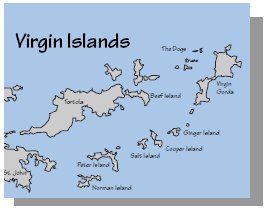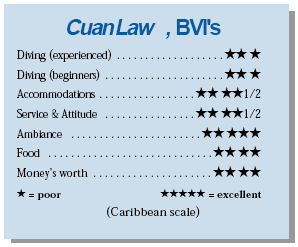Diving and R&R in the British VirginsContents of this Issue: Diving and R&R in the British Virgins The Ongoing Fight Against Mail Order A Letter to DAN & Dive Training — and it's not junk mail Thumbs Down — Divers Get Taboo Treatment from Fiji's Taveuni Island Resort Editorial Office: Ben Davison Publisher and Editor Undercurrent 3020 Bridgeway, Suite 102 Sausalito, CA 94965 Smooth Sailing Aboard the Cuan Law from the April, 2000 issue of Undercurrent
An adventurous live-aboard veteran knows what it’s like to struggle against waves and currents, be engulfed by churning surge, get jerked, pushed and pulled by a powerful ocean, wait on the surface hoping that the tinny will find you, kick up and climb, exhausted, over its gunwales, and maybe lose your lunch along the way. Often that’s the price of admission to unique critters, big animals, and world-class diving, and, except for diving along the Pacific coast of the Americas, it’s often a two-day flight each way just to get to it. Then again, there is another live-aboard style suitable for easy divers, spouses who don’t dive, families, and even dedicated, albeit amateur, underwater photographers. It’s a liveaboard, but not one dedicated to divers, where beach visits, snorkeling, sailing, kayaking, water-skiing and deck sunning are all vital to the experience. And, the Cuan Law, a comfortable giant trimaran that plies the calm waters off the British Virgin Islands, is the best example I can think of. Although the BVIs are shy on large animals and world-class visibility, they have some famous wrecks, spectacular facades, and wonderful sailing. The Cuan Law’s the perfect boat for the calm waters skirting
the scores of islands here. The sails mean you’re not
dependent on the grind of the engine, and the engine means
you’re not dependent on the wind. It seems a good combination,
efficiency married to relaxation. The unique three-pontoon
design is the creation of owners Duncan and Annie Muirhead and
is as spacious as it is unusual. The roomy deck is strung with
hammocks -- handy for sunset watching -- while the interior’s
so capacious they could -- and did -- lay out dinner for eighteen
on teak tables set end to end. The 20'x40' living room
has lots of space to stretch your legs; a wet bar is open 24/
hrs./day, and in the audio/video room, movies run nonstop. Of course, my raison d’être for boarding this craft was diving, and what I got was the easy Caribbean variety, populated by a wide range of marine life ranging from flamingo tongues, grunt, yellow snapper, green and spotted morays, angel fish -- all the fish you would expect (although most dives were also teeming with moon jellyfish) -- flitting among healthy coral. In fact, it’s not too dissimilar from the Bahamas, and, except for the more stellar Caribbean sites like Little Cayman, it holds its own. Marine maps on the wall were updated daily to mark the ship’s course as it snaked its way among the 40-plus islands of the BVIs, all of them tucked within a 35-mile-wide span. Dive sites were marked there, too, so there were no surprises. Our briefing’s dryboard sketches and ring-binder diagrams might have been elaborate, but when they were finished I knew where to find things -- that makes it easy for the photographer. While we were allowed to dive our computers, most of my 14 dives were 45-minute ones on sites in the 40-70' range; only a couple were deeper. Half were off the mother ship, half off hard-bottom inflatables. The wreck of the Chikuzen, a 246' refrigerator ship sunk off Tortola in 75' of water in 1981, attracts swarms of snapper. In 70' visibility, I liked swimming through the schools, watching them uniformly part, change direction, and circle about the newly created hole -- like joining the school, just not quite as graceful or in tune as the rest of the students. A goal of mine on this trip was to shoot an orange ball corallimorph, a somewhat rare and very unusual critter -- a globe of 50 or so 2" long translucent arms jutting from its smaller body, each with a brilliant orange ball at the end. One my fellow Undercurrent readers reported a couple of the nocturnal critters on the wreck of the RMS Rhone, the craft featured (largely in facsimile) in the 1978 Jacqueline Bissett/ Nick Nolte film “The Deep,” which was allegedly set in Bermuda. The 310-foot Rhone sank in a hurricane in 1867 while steaming toward open seas. After striking rocks, the hull broke in two: the shallow stern section now rests at 30', the deeper bow section at 85'. The stern’s perfect for snorkelers with plenty of predictable marine life. After a giant stride entry, I descended for the morning dive, and I soon found the resident “Fang,” a 5' barracuda, a willing subject for my camera. Visibility in the stern was only fair, but the well populated schools of snappers, jacks, grunts, and yellowtail easily stood out. Our briefing had stressed the ugly fish, so when the divemaster urged me to peer into a porthole, I thought nothing of it, but hey, another great shot! It was me, reflected in a mirror on the other side. Later, exploring the bow, I found the other wreck resident we’d been advised to look for during our briefing -- a 300-lb. Jewfish. Maybe the crew had seen so much of this monster they’d come to take him in stride, but for me, swimming up to a fish that not only outsizes you but whose mouth could close over your shoulder the way mine would over a burger -- well, calm as he was, he had my full attention. I figured the Rhone night dive was my shot at seeing my orange critter and that I’d
better confirm that everyone in the crew knew what I was after, so that afternoon I
made the rounds with their copy of
Humann’s Reef Creatures in hand, flashing
my photo and telling them to keep their
eyes peeled. The guide who pointed out the corallimorph was a member of a helpful, punctual, but unharried crew. In my college days, when I worked summers as a dive instructor on a cruise ship, I learned how miserable these jobs can be. While I’ve seen burned-out dive staffs, brittle around the edges, to whom the guests have become a pain, that’s not the case on the Cuan Law. The busy crew not only went out of their way to help; they enjoyed it. Kiwi, the divemaster from down under, was full of energy and always game, ready to interrupt what she was doing to get kayaks for a guest or urge on the inexperienced water skier, “one more try!” Captain Gerry Matt, a photo expert and video professional, was always hustling, one of those everywhere-at-once bits of sleight-ofhand where he’d drive the boat, help set up the dinner table, pick up around the deck, and still always be around at the right moment to get that perfect above or below water shot, all of which he assembled -- with music, titles, and slick transitions -- for the end-of-week, souvenir-for-sale video. The staff likes being there, and it shows. The capable English chef, Tanya Wohner, produced hearty American fare, but not the haute cuisine I’d hoped for. Dinners included “turkey ‘n fixins,” ribs, and chicken with sauté sauce, always with veggies and salad. Fish was absent (ciguatera toxin renders the local tuna, grouper, and other fish inedible; ingest it and one can contract a serious lingering illness that might even mean paralysis). The buffet-style breakfasts included French toast or baked eggs, fruits, breads, and cereals; lunches were the best meals, including offerings like broiled chicken with peanut sauce. Between meals, cheese and crackers, smoked fish, popcorn, or mixed nuts were set out for snacks. As you know by now, a trip aboard the Cuan Law is combination of good, easy diving a couple times a day and a relaxing, elegant sailing trip through calm waters without the grind of the engines or the smell of diesel wafting your way. Of course, I could just as easily have worn myself out water skiing, paddling sea kayaks, pitching in with sailing the Cuan Law and downsized sailing in the hobie cats, and side junkets. On Tortola (which, at 40 miles long, is the largest of the BVIs), I found the trip to the “baths” a great outing. This oversized obstacle course is an amazing mass of boulders and rocks larger than small homes ... crawling through narrow crevices, wading though crystal blue water, lowering myself by rope down slippery edges, taking pause at the natural beauty of the sun shimmering through the cracks between the rocks and wondering how this amazing compilation of stones had been formed. All in all, a week aboard this trimaran has just enough good diving to satisfy many serious divers, and enough elegance, touring, and recreation to satisfy everyone else. It was a laid-back change of pace for me, but next trip it’s back to the big ocean, currents, surge ... and big stuff. — C.M. |

I want to get all the stories! Tell me how I can become an Undercurrent Online Member and get online access to all the articles of Undercurrent as well as thousands of first hand reports on dive operations world-wide
| Home | Online Members Area | My Account |
Login
|
Join
|
| Travel Index |
Dive Resort & Liveaboard Reviews
|
Featured Reports
|
Recent
Issues
|
Back Issues
|
|
Dive Gear
Index
|
Health/Safety Index
|
Environment & Misc.
Index
|
Seasonal Planner
|
Blogs
|
Free Articles
|
Book Picks
|
News
|
|
Special Offers
|
RSS
|
FAQ
|
About Us
|
Contact Us
|
Links
|
3020 Bridgeway, Ste 102, Sausalito, Ca 94965
All rights reserved.

 The
ten 10’x10' cruise ship cabins, all off the main lounge, sport side-by-side beds, good storage, flush toilets,
and an odd but functional bath that converts
via an easily elevated faucet into a whole-room
shower with plenty of water (though, watch it;
the whole room gets wet!). A rash of windows
counteract that closed-in feeling. My only
complaints were some nighttime compressor noise
in my forward central cabin and the a/c, which
at full blast barely kept the room comfortable,
although the fan beefed it up.
The
ten 10’x10' cruise ship cabins, all off the main lounge, sport side-by-side beds, good storage, flush toilets,
and an odd but functional bath that converts
via an easily elevated faucet into a whole-room
shower with plenty of water (though, watch it;
the whole room gets wet!). A rash of windows
counteract that closed-in feeling. My only
complaints were some nighttime compressor noise
in my forward central cabin and the a/c, which
at full blast barely kept the room comfortable,
although the fan beefed it up. Then, after I backrolled off
the dinghy, I began to search the crannies
for the corallimorph without success,
until a guide motioned me to follow him.
He pointed toward something tucked into a
crevice, and, sure enough, there was the
aloof orange-ball corallimorph, an even
more amazing little critter in the flesh.
He was quite resistant to the effects of
the strobe, which I fired at least 20
times, determined to get it right.
Then, after I backrolled off
the dinghy, I began to search the crannies
for the corallimorph without success,
until a guide motioned me to follow him.
He pointed toward something tucked into a
crevice, and, sure enough, there was the
aloof orange-ball corallimorph, an even
more amazing little critter in the flesh.
He was quite resistant to the effects of
the strobe, which I fired at least 20
times, determined to get it right. Diver’s Compass: Cuan Law/Trimarine:
phone 800-648-3393;
Diver’s Compass: Cuan Law/Trimarine:
phone 800-648-3393;
